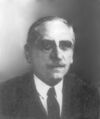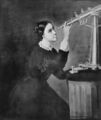Template:Selected anniversaries/June 28: Difference between revisions
No edit summary |
No edit summary |
||
| (8 intermediate revisions by the same user not shown) | |||
| Line 5: | Line 5: | ||
||1717: Matthew Stewart born ... mathematician and minister of religion. Pic. | ||1717: Matthew Stewart born ... mathematician and minister of religion. Pic. | ||
||1740: Physician and soldier Moses Nichols born ... American Revolution. Pic search gravestone. | |||
||1754: Martin Folkes dies ... antiquary, numismatist, mathematician, and astronomer. Pic. | ||1754: Martin Folkes dies ... antiquary, numismatist, mathematician, and astronomer. Pic. | ||
| Line 16: | Line 18: | ||
||1852: Wilhelm Hisinger dies ... physicist and chemist who in 1807, working in coordination with Jöns Jakob Berzelius, noted that in electrolysis any given substance always went to the same pole, and that substances attracted to the same pole had other properties in common. This showed that there was at least a qualitative correlation between the chemical and electrical natures of bodies. Pic. | ||1852: Wilhelm Hisinger dies ... physicist and chemist who in 1807, working in coordination with Jöns Jakob Berzelius, noted that in electrolysis any given substance always went to the same pole, and that substances attracted to the same pole had other properties in common. This showed that there was at least a qualitative correlation between the chemical and electrical natures of bodies. Pic. | ||
||1873: Alexis Carrel born ... surgeon and biologist, Nobel Prize laureate. | ||1873: Alexis Carrel born ... surgeon and biologist, Nobel Prize laureate ... Perfusion pump w/ Charles Lindbergh. Pic. | ||
File:Henri Lebesgue.jpg|link=Henri Lebesgue (nonfiction)|1875: Mathematician and academic [[Henri Lebesgue (nonfiction)|Henri Lebesgue]] born. He will gain fame for his his theory of integration, which generalizes the 17th century concept of integration (summing the area between an axis and the curve of a function defined for that axis). | File:Henri Lebesgue.jpg|link=Henri Lebesgue (nonfiction)|1875: Mathematician and academic [[Henri Lebesgue (nonfiction)|Henri Lebesgue]] born. He will gain fame for his his theory of integration, which generalizes the 17th century concept of integration (summing the area between an axis and the curve of a function defined for that axis). | ||
||1879: Wilhelm Steinkopf born ... chemist ... worked on the production of mustard gas during World War I. Pic search | ||1879: Wilhelm Steinkopf born ... chemist ... worked on the production of mustard gas during World War I. Pic search. | ||
File:Maria Mitchell.jpg|link=Maria Mitchell (nonfiction)|1889: Astronomer and academic [[Maria Mitchell (nonfiction)|Maria Mitchell]] dies. She was the first American woman to work as a professional astronomer. | File:Maria Mitchell.jpg|link=Maria Mitchell (nonfiction)|1889: Astronomer and academic [[Maria Mitchell (nonfiction)|Maria Mitchell]] dies. She was the first American woman to work as a professional astronomer. | ||
| Line 36: | Line 34: | ||
||1911: Martian meteorite Nakhla falls in Egypt. It was the first meteorite reported from Egypt, the first one to suggest signs of aqueous processes on Mars, and the prototype for Nakhlite type of meteorites. It fell on Earth on June 28, 1911, at approximately 09:00, in the Abu Hommos district, Alexandria Governorate, Egypt (now Abu Hummus, Beheira Governorate), in the area of the village of El Nakhla El Bahariya. | ||1911: Martian meteorite Nakhla falls in Egypt. It was the first meteorite reported from Egypt, the first one to suggest signs of aqueous processes on Mars, and the prototype for Nakhlite type of meteorites. It fell on Earth on June 28, 1911, at approximately 09:00, in the Abu Hommos district, Alexandria Governorate, Egypt (now Abu Hummus, Beheira Governorate), in the area of the village of El Nakhla El Bahariya. | ||
||1912: Carl Friedrich von Weizsäcker born ... physicist and philosopher. | ||1912: Carl Friedrich von Weizsäcker born ... physicist and philosopher. Pic. | ||
||1914: Aribert Heim born ... SS physician and Nazi war criminal. | ||1914: Aribert Heim born ... SS physician and Nazi war criminal. Pic. | ||
||1919: The Treaty of Versailles is signed, ending the state of war between Germany and the Allies of World War I. | ||1919: The Treaty of Versailles is signed, ending the state of war between Germany and the Allies of World War I. | ||
||1926: Robert Ledley born ... academic and inventor. | ||1926: Robert Ledley born ... academic and inventor ... professor of physiology and biophysics and professor of radiology at Georgetown University School of Medicine, pioneered the use of electronic digital computers in biology and medicine. Pic. | ||
||1927: Frank Sherwood Rowland born ... chemist and academic, Nobel Prize laureate. | ||1927: Frank Sherwood Rowland born ... chemist and academic, Nobel Prize laureate. Pic. | ||
||1928: Gordon Pask born ... author, inventor, educational theorist, cybernetician and psychologist who made significant contributions to cybernetics, instructional psychology, experimental epistemology and educational technology. Pic. | ||1928: Gordon Pask born ... author, inventor, educational theorist, cybernetician and psychologist who made significant contributions to cybernetics, instructional psychology, experimental epistemology and educational technology. Pic. | ||
| Line 51: | Line 49: | ||
||1941: Joseph Amadee Goguen born ... computer scientist. Pic. | ||1941: Joseph Amadee Goguen born ... computer scientist. Pic. | ||
||1941: German weather ship Lauenburg captured by Royal Navy forces. Lauenburg was used in the early years of the Second World War to provide weather reports for German shipping, particularly German U-boats. After the German use of such vessels had been identified as a weakness that could be exploited to break the Enigma code, Lauenburg was captured and sunk. The Royal Navy acquired important German code books and parts of an Enigma machine. | |||
||1950: Korean War: North Korean Army conducts Seoul National University Hospital massacre. | ||1950: Korean War: North Korean Army conducts Seoul National University Hospital massacre. | ||
| Line 59: | Line 59: | ||
||1972: Prasanta Chandra Mahalanobis dies ... scientist and applied statistician. He is best remembered for the Mahalanobis distance, a statistical measure and for being one of the members of the first Planning Commission of free India. Pic. | ||1972: Prasanta Chandra Mahalanobis dies ... scientist and applied statistician. He is best remembered for the Mahalanobis distance, a statistical measure and for being one of the members of the first Planning Commission of free India. Pic. | ||
||1981: A powerful bomb explodes in Tehran, killing 73 officials of the Islamic Republican Party. | ||1981: A powerful bomb explodes in Tehran, killing 73 officials of the Islamic Republican Party. | ||
||1982: Igor | ||1982: Igor Gouzenko dies ... cipher clerk for the Soviet Embassy to Canada in Ottawa, Ontario. He defected on September 5, 1945 – just three days after the end of World War II – with 109 documents on Soviet espionage activities in the West. Pic (wearing hood mask during testimony - how cool is that?). | ||
||1984: Claude Chevalley dies ... mathematician who made important contributions to number theory, algebraic geometry, class field theory, finite group theory, and the theory of algebraic groups. Pic. | ||1984: Claude Chevalley dies ... mathematician who made important contributions to number theory, algebraic geometry, class field theory, finite group theory, and the theory of algebraic groups. Pic. | ||
||2000: Aubrey William Ingleton dies ... mathematician. His work on matroids culminated in the paper "Representation of matroids" published in 1969. In his work Ingleton studied matroids as a generalization of the concept of linear independence. The paper is a survey about representable matroids as it exhibited matroids representable over C but not over R and similarly over R but not over Q. He included in his paper a single theorem which is a necessary condition of the representability of matroids. This condition is known in the literature as Ingleton's Inequality. Pic: https://pdfs.semanticscholar.org/5d82/39acfc6c6ac78aad9959c4650507c45f6f2e.pdf | ||2000: Aubrey William Ingleton dies ... mathematician. His work on matroids culminated in the paper "Representation of matroids" published in 1969. In his work Ingleton studied matroids as a generalization of the concept of linear independence. The paper is a survey about representable matroids as it exhibited matroids representable over C but not over R and similarly over R but not over Q. He included in his paper a single theorem which is a necessary condition of the representability of matroids. This condition is known in the literature as Ingleton's Inequality. Pic: https://pdfs.semanticscholar.org/5d82/39acfc6c6ac78aad9959c4650507c45f6f2e.pdf | ||
File:Evening rain (28 June 2023) 20230628_210003.jpg|link=Evening rain (28 June 2023)|2023: '''[[Evening rain (28 June 2023)|Evening rain]]''' @ 9:03. | |||
</gallery> | </gallery> | ||
Latest revision as of 18:20, 28 June 2024
1598: Cartographer and geographer Abraham Ortelius dies. Ortelius created the first modern atlas, the Theatrum Orbis Terrarum. He was also one of the first to imagine that the continents were joined together before drifting to their present positions.
1712: Philosopher and author Jean-Jacques Rousseau born. His political philosophy will influence the Enlightenment in France and across Europe.
1824: Physician, anatomist, and anthropologist Paul Broca born. He will discover that the brains of patients suffering from aphasia contain lesions in a particular part of the cortex, in the left frontal region -- the first anatomical proof of the localization of brain function.
1825: Chemist and academic Emil Erlenmeyer born. He will contribute to the early development of the theory of structure, formulating the Erlenmeyer rule, and designing the Erlenmeyer flask.
1875: Mathematician and academic Henri Lebesgue born. He will gain fame for his his theory of integration, which generalizes the 17th century concept of integration (summing the area between an axis and the curve of a function defined for that axis).
1889: Astronomer and academic Maria Mitchell dies. She was the first American woman to work as a professional astronomer.
1906: Physicist and academic Maria Goeppert-Mayer born. She will develop a mathematical model for the structure of nuclear shells, for which she will be awarded the Nobel Prize in Physics in 1963, which she will share with J. Hans D. Jensen and Eugene Wigner.
2023: Evening rain @ 9:03.







